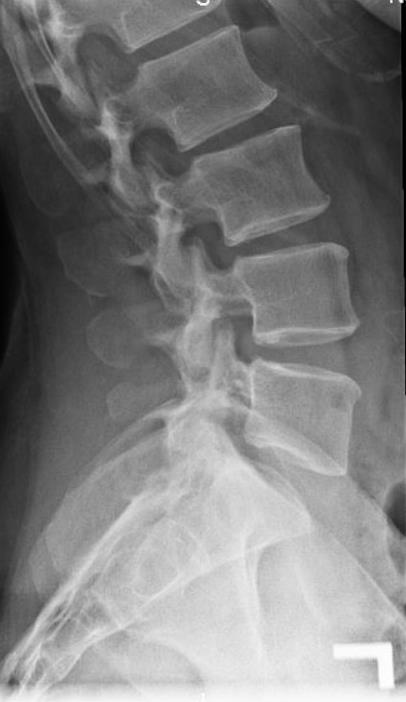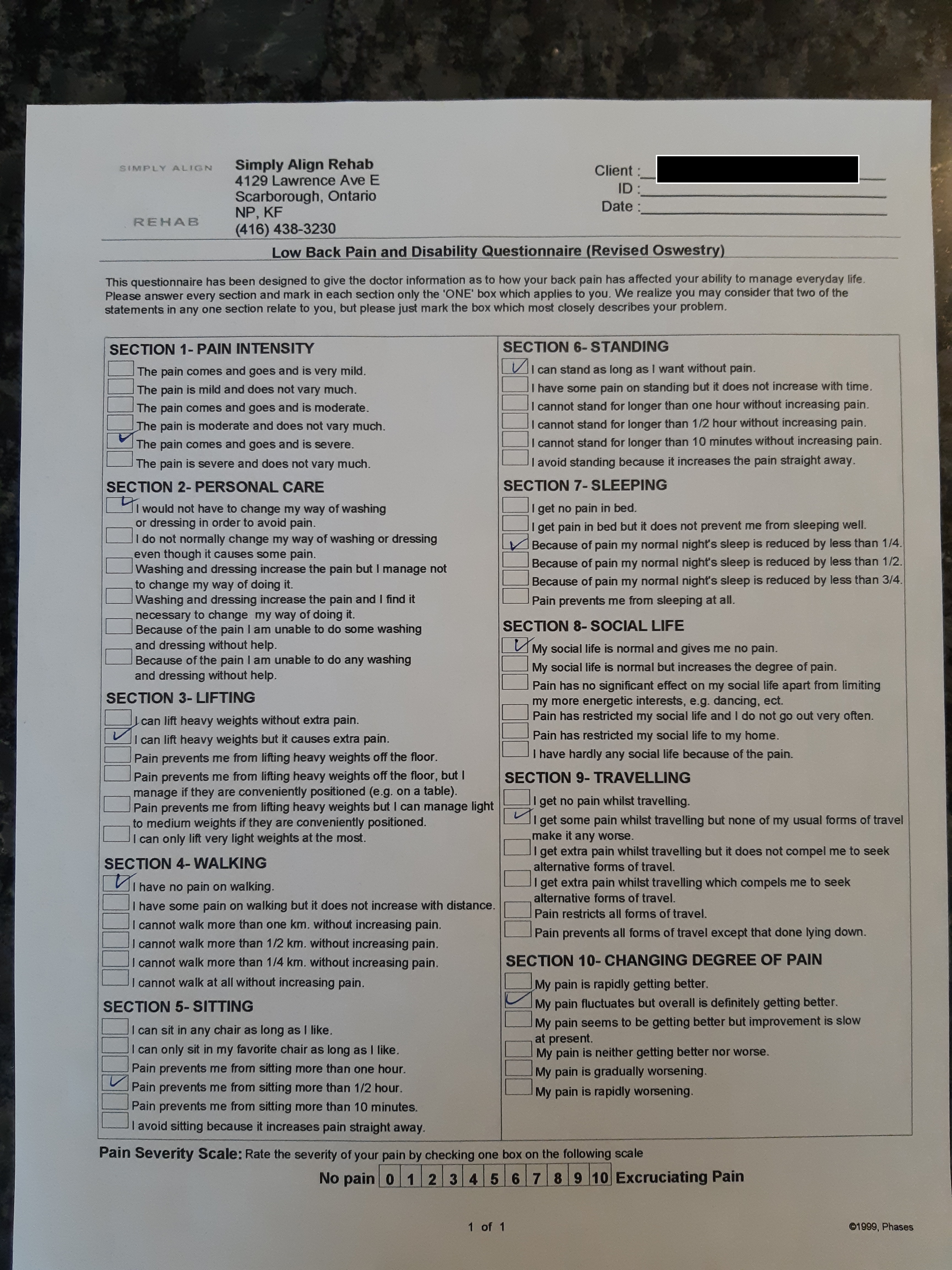Initial Exam
Examination Date: 02/03/2018
Chief Complaints
- Bilateral Lower Back
She describes a complaint of bilateral lower back pain. Patient reports insidious onset of the complaint for the past two years. She rated this pain as a 7 on a scale of 0 to 10 with 10 being the worst and considers this condition to be moderate. The pain is frequent according to the patient. The pain is described as aching and dull and occurs most often in the morning. Patient reported to have pain during sleep and early in the morning. The pain is reduced by resting while bending and lifting aggravates the condition.
History
Patient has liver issues, fatty liver.
Oswestry Low Back Disability Index
The patient was asked to complete the Oswestry low back questionnaire. The disability score calculated was 26%. Their responses are as follows.
The pain comes and goes and is moderate. I would not have to change my way of washing or dressing in order to avoid pain. Pain prevents me from lifting heavy weights but I can manage light to medium weights if they are conveniently positioned. I have no pain on walking. Pain prevents me from sitting for more than one hour. I have some pain on standing but it does not increase with time. Because of pain my normal nights sleep is reduced by less than 1/4. My social life is normal and gives me no pain. I get no pain while traveling. My pain seems to be getting better but improvement is slow at present.
Physical Examination
Physical examination revealed an individual who was alert, cooperative and orientated.
The patient’s gait appeared normal. Minor’s sign was negative.
Sex: Female
Age: 43
Complexion: Normal
Size: Normal
Posture
There is no indication of a head tilt in the patient’s posture. Her shoulder level appeared even bilaterally. There is no evidence of a forward head carriage. Her ilium level appeared even bilaterally. Observation and inspection of the thoracic spine revealed a normal spine. Profile view of the lumbar spine revealed normal curvature. Romberg’s test was negative. Adam’s sign was negative. Left heel walk: WNL. Right heel walk: WNL. Left toe walk: WNL. Right toe walk: WNL. Trendelenberg test on the left was negative. Trendelenberg test on the right was negative.
Ranges of Motion
Lumbar Spine
Motion Degree Normal Pain Level
Flexion: 62 60 Mild
Extension: 28 25 Mild
Lateral Right: 30 25 Mild
Lateral Left: 29 25 Mild
Lumbar Spine Evaluation
Lumbar spine evaluation provided the following results:
Evaluation of the lumbar spinal region reveals tender areas in the lumbar region on both sides (grade 2) and erector spinae on both sides (grade 2). Palpation of the spine indicated discomfort and pain in the spinous process at: L4, L5 and S1 (grade 2). Evaluation of the lumbar spinal areas indicates that trigger points are present in the erector spinae bilaterally (moderate) and quadratus lumborum bilaterally (moderate). Braggard’s sign was negative bilaterally. Hoover test result was negative. Kemps was positive on the left. The patient reported localized low back pain during the test. Kemps was positive on the right. The patient reported localized low back pain during the test. Patrick-Fabere test was negative on the left and the right. Milgram’s test was negative. Valsalva’s test was negative. The following lumbar orthopedic tests were negative: hip circumduction bilaterally.
X-Ray Analysis
Lumbar
The following views were taken: A-P and lateral. Radiographic examination revealed no fractures, dislocations or osseous blastic/lytic lesions. Normal alignment of the lumbar spine both on AP and lateral views. Disc space is well maintained. No other abnormalities seen. .
Impression
Normal findings.
Diagnosis
M545 Low back pain
S335 Sprain and strain of lumbar spine
Chronic recurrent, mild to moderate postural and lifestyle condition in the above region with associated symptoms of pain and functional difficulties.
Management Plan
Short Term Goals would be for patient to report 50% pain reduction and 50% within 2 weeks. Functionally patient should also be able to perform half of his ADL’s within these 2 weeks easier. Long Term Goals would be for patient to report over 80% pain reduction and demonstrate over 80% within 4 to 6 weeks. Functionally patient should also be able to perform most of his ADL’s within this period. Patient is also to be discharged with a home exercise program when the above goals have been achieved and he is over 80-90% impairment free.
Today’s Treatments
Simply Align Technique for 15 min that included laser physiotherapy, pulswave physiotherapy and radio-frequency physiotherapy. Patient is told to not do anything different at home.
Prognosis
The prognosis for improvement of the patient’s condition is considered good.
Treatments Provided by: Nima Pardisnia, PT.
Intermediate Exam
Examination Date: 09/03/2018
Chief Complaint
- Bilateral Lower Back
She is complaining of bilateral lower back pain. Ms. XXXXXXX feels better since the start of the treatments. She rated this pain as a 3 on a scale of 0 to 10 with 10 being the worst and considers this condition to be mild. The pain is intermittent according to the patient. The pain is expressed as aching and dull. The pain is reduced by resting while bending and lifting aggravates the condition.
Oswestry Low Back Disability Index
The patient was asked to complete the Oswestry low back questionnaire. The disability score calculated was 14%. Their responses are as follows.
The pain comes and goes and is very mild. I would not have to change my way of washing or dressing in order to avoid pain. Pain prevents me from lifting heavy weights but I can manage light to medium weights if they are conveniently positioned. I have no pain on walking. Pain prevents me from sitting for more than one hour. I can stand as long as I want without pain. I get pain in bed but it does not prevent me from sleeping well. My social life is normal and gives me no pain. I get no pain while traveling. My pain is rapidly getting better.
Physical Examination
Physical examination revealed an individual who was alert, cooperative and orientated.
The patient’s gait appeared normal. Minor’s sign was negative.
Sex: Female
Age: 43
Complexion: Normal
Size: Normal
Posture
There is no indication of a head tilt in the patient’s posture. Her shoulder level appeared even bilaterally. There is no evidence of a forward head carriage. Her ilium level appeared even bilaterally. Observation and inspection of the thoracic spine revealed a normal spine. Profile view of the lumbar spine revealed normal curvature. Romberg’s test was negative. Adam’s sign was negative. Left heel walk: WNL. Right heel walk: WNL. Left toe walk: WNL. Right toe walk: WNL. Trendelenberg test on the left was negative. Trendelenberg test on the right was negative.
Ranges of Motion
Lumbar Spine
Motion Degree Normal Pain Level
Flexion: 65 60 No
Extension: 30 25 No
Lateral Right: 36 25 No
Lateral Left: 35 25 No
Lumbar Spine Evaluation
Lumbar spine evaluation provided the following results:
Evaluation of the lumbar spinal region reveals tender areas in the lumbar region on both sides (grade 2) and erector spinae on both sides (grade 1). Palpation of the spine indicated discomfort and pain in the spinous process at: L4, L5 and S1 (grade 1). Evaluation of the lumbar spinal areas indicates that trigger points are present in the erector spinae bilaterally (mild) and quadratus lumborum bilaterally (mild). Braggard’s sign was negative bilaterally. Hoover test result was negative. Kemps was negative on the left. Kemps was negative on the right. Patrick-Fabere test was negative on the left and the right. Milgram’s test was negative. Valsalva’s test was negative. The following lumbar orthopedic tests were negative: hip circumduction bilaterally.
Diagnosis
M545 Low back pain
Chronic recurrent, mild to moderate postural and lifestyle condition in the above region with associated symptoms of pain, ROM reduction and functional difficulties.
Management Plan
Patient is being discharged at this time. She has achieved 80% improvement both subjectively and objectively since the start of the treatments. Continuation with home exercise program and return to therapies should the impairments return is recommended.
Today’s Treatments
Simply Align Technique for 15 min, and discharge patient.
Notes: This patient has had chronic lower back pain waking her up in the morning for two years. Total of three treatments were rendered each 15 min. No other exercise or modifications were recommended. Significant improvements was reporte after only three treatments. Lower back disability index was reduced to 14% from 26% in one week. Objectively after three visits pain free full ROM was noted using Acumar Digital Dual Inclinometer. Tenderness and orthopedic tests were all negative.
Follow up date 20/01/2019 (9 months later):
Follow up email from the patient: “I don’t have pain anymore. My pain in 2016 was very bad at the point where I couldn’t t sleep a whole night, neither lay down on my back. Now I don’t feel that pain anymore. I keep exercising every week.” Oswestry Low Back Disability Index score 18%, this is minimal disability verses original moderate disability of 26%.
Also Read
| Low Back Pain | Low Back Osteoarthritis | Scoliosis | Sciatica |
| Case Study: Subacute Neck Pain Simply | Case Study: Acute Lower Back Pain | Case Study: Subacute Lower Back Pain | Case Study: Chronic Lower Back Pain |
| Case Study: Lateral Epicondylosis | Case Study: L5-S1 Disc Prolapse | Case Study: Right lateral disc protrusion at L5-S1 | |



